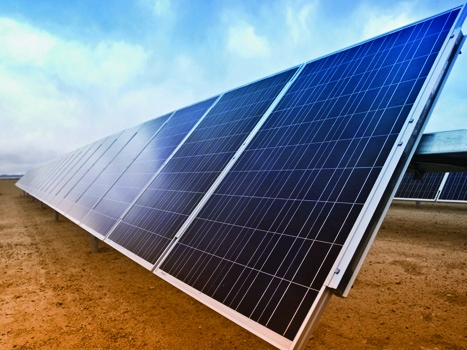
While large desert-based solar-energy installations provide abundant amounts of clean energy, they can also become coated in fine particles of sand, leading to a decrease in their efficiency. For that reason, they must be cleaned at regular monthly intervals - a labour-intensive process that can damage the surface of the solar panels.
Now, UK start-up Chamelic has developed a novel solution to the problem - a dust-resistant coating that can be applied to the surface of the photovoltaic panels and solar concentrator mirrors to actively repel dust for a considerable period of time. The technology is already being trialled in several photovoltaic plants in Spain and the Middle East, and the results, so far, look promising.
Leeds Innovation Centre-based Chamelic was established in 2006 to exploit the technology developed by the research group of Prof Simon Biggs at the Institute of Particle Science and Engineering at the University of Leeds. Under Biggs’ guidance, the Chamelic team has developed a methodology to tune the properties of polymers using controlled radical polymerisation so that they can then be used as surface treatments that provide many beneficial properties.
According to Sasha Heriot, business development manager at Chamelic, the company has since used that methodology to create a number of different water-based coatings that can be applied to a range of substrates, including metal, glass, plastic and painted surfaces. Such coatings can provide a number of significant advantages - not simply the ability to repel dust, but also to promote water wetting and anti-fogging.
The technology behind the coatings that the company produces involves using commercially available monomers to grow two blocks of polymerised monomers - one of which is hydrophobic (water hating) and the other hydrophilic (water loving). When these are dissolved in water, they self-assemble into spheres called micelles that can then be applied to a surface, upon which they are adsorbed.
Heriot explained that, when this happens, the morphology of the micelles changes - they form dome-shaped structures on the surface, with the hydro-phobic part forming a physical bond with the surface, leaving the hydrophillic part of the micelles exposed to the elements.
’When a surface treated with one such coating is exposed to water, rather than beading occurring on the surface, the water wets the surface and forms a thin layer. As a result, the surface not only dries faster but there are no water marks left on it when the water evaporates - an effect that can occur when using alternative hydrophobic-type coatings,’ said Heriot.
With Repelsmart energy companies can significantly increase the output from their solar installations
To create the company’s Repelsmart Solar product, the researchers chemically engineered the heads of the micelles so that they became negatively charged. Since most dust that occurs in the desert environment is negatively charged, the surface treatment repels the dust from the surface of any photovoltaic panel that it is applied to.
According to Chamelic’s chief executive officer, Jeff Eaves, Repelsmart does not absorb visible light, nor does it change the optical properties of the surface that it is applied to - there are no light-transmission losses through the glass after it has been treated. What is more, like all of the company’s water-borne coatings, it can be applied easily using methods such as spraying, dipping or flow coating.
Although the surface treatments, which produce a coating around 10-20nm thick, are not permanent and will wash off eventually, the tests that Chamelic’s researchers and its customers have performed to date indicate that they do have a reasonable durability and can, in certain cases, last up to a year.
Eaves said that one litre of the company’s dust-repellent solution will treat approximately 10m2 of a solar PV panel. While the company is not yet releasing any details of what such a treatment might cost, Eaves claimed that Chamelic will provide an economically feasible means by which energy companies can significantly increase the output from their solar installations.
To manufacture its products on a large scale, Chamelic has recently formed a relationship with an unspecified blue-chip chemical company that it is presently working with to scale up its present lab-based production process.
Design Essentials
The key facts to take away from this article
- Repelsmart is applied to photovoltaic panels to actively repel dust
- The polymers’ properties are tuned using radical polymerisation
- The coating is formed from hydrophobic and hydrophilic monomers
- These then self-assemble into micelles that can be used to treat a surface




Project to investigate hybrid approach to titanium manufacturing
What is this a hybrid of? Superplastic forming tends to be performed slowly as otherwise the behaviour is the hot creep that typifies hot...